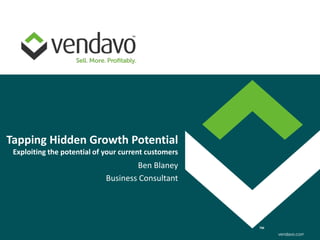Tapping Hidden Growth Potential in Your Customer Portfolio
- 1. Tapping Hidden Growth Potential Exploiting the potential of your current customers Ben Blaney Business Consultant
- 2. Agenda • Why? • Types of Growth opportunities • How to identify • Size the prize • Capture • Questions
- 3. Why?
- 4. Existing customers are your biggest opportunity And your biggest risk
- 9. Types of Growth Improve Share of Wallet Upgrade the mix Cross-Sell / Up-Sell / Down-Sell Service Parts Rebates
- 10. How to identify
- 11. Improve Share of Wallet These are attractive customers Impact on your business of moving them is HUGE!
- 12. Upgrade the Mix
- 13. Cross-sell / Up-sell / Down-sell
- 15. Rebates to drive volume/mix Previous Volume Forecast Volume $ per The unit Incentive Zone! V Units Previous Volume Forecast Volume $ per unit V Units
- 16. Size the prize
- 17. Size the prize Current profit + share of wallet + upgrade +upsell + service parts – increased rebates = new profit Current Share of Upgrade Up-sell Service Increased New profit profit wallet the mix parts rebates
- 18. Best Practices • Have Finance run the calculations • There’s credibility in independent verification • Don’t sandbag too much
- 19. Capture
- 20. Capture • Need granular steps – it’s all in the detail • Incentives for commercial teams • Publication of performance improvements • Executive alignment • Celebrate success! Recommended Reading, on how to drive behavior change
- 21. Questions?
- 22. Questions
- 23. Thank you! Feel free to contact me: Ben Blaney Business Consultant Email: bblaney@vendavo.com Cell: 719.357.2425
Editor's Notes
- #5: Provocation.There is a debate about relative cost of acquiring customers and retaining customers…but that’s not the point.It’s harder to attract new customers than to grow your current ones.Why?Because if you believe that customers will switch, you have to also believe they’ll switch back again – and that’s a zero sum game.But if you believe that your customers are YOUR customers because of something of value they find in buying from your company, then they’re more sticky.
- #12: Three types of SOW:1. How much of the total spend of product x do I have (customer classification)2. How much of the total addressable customer spend do I have3. Proportion of your product in customer’s productThe table stakes here is to have customer intimacy and customer intelligence.You need to know that customers have you and your competitor. What do you need to do to displace? Need to understand the reasons why your customer keeps two vendors – is it to maintain downward pricing pressure on both, or for operational security. If the latter, can you solve that problem for them, with VMI, or improved SLA?Think about your white space – same customer, adjacent product; same product, adjacent customer. What corporate strategy items play into this? Top level goals? Acquisition plans?
- #13: There is upgrade the product mix within customer, and also upgrade the customer mix within your business.<anecdote> at one of our profit hero diners, a customer shared information about how they improved margins in a commodity business with fixed set of commodities. Expected 5c/lb margin variance across customers. Shocked to find 55c variance. Took that variance in a box plot, realized that we had different customer groups buying same item. Competitors were letting us have this business. We had to focus more on the higher margin accountsUpgrade the mix by solid product understanding. Where can you switch a customer to same form, fit, function – but to a SKU that’s more profitable.Is it possible to create eligibility to buy rules, so that your crappy customers can’t buy your crappy SKUs?If you have this information at quote time, you can arm your salespeople to execute
- #14: This is a basic concept, yet we’re surprised how few prospects and customer use this well.This is marketing’s job. Why not an extension of responsibility to maintain a table of cross up and down sell options?The ratio of work to benefit is 1 person’s work to however many salespeople who have. This is guided selling. This is like being able to put marketing on the shoulder of the salesperson.Level 1 is product-productLevel 2 adds dimension, region-specific, or end-use industry specific. Don’t forget down-sell. Can drive margin by selling lower-end products, and avoids price compression on premium products.
- #15: New product manager finds that spare parts to a top 3 customer are under waterWould take a doubling of the price to get to a mediocre margin levelSettle on a 55% increaseCEO to CEO call. “we wondered when you were going to figure that out”
- #16: Stepped volume discounts should only start beyond the point of natural growth.With steps, you may as well re-price to the average and be done with it. Steps encourage over-promising.Rebates put the risk on the purchaser.Throw in a reference to rebates in PMM.




























